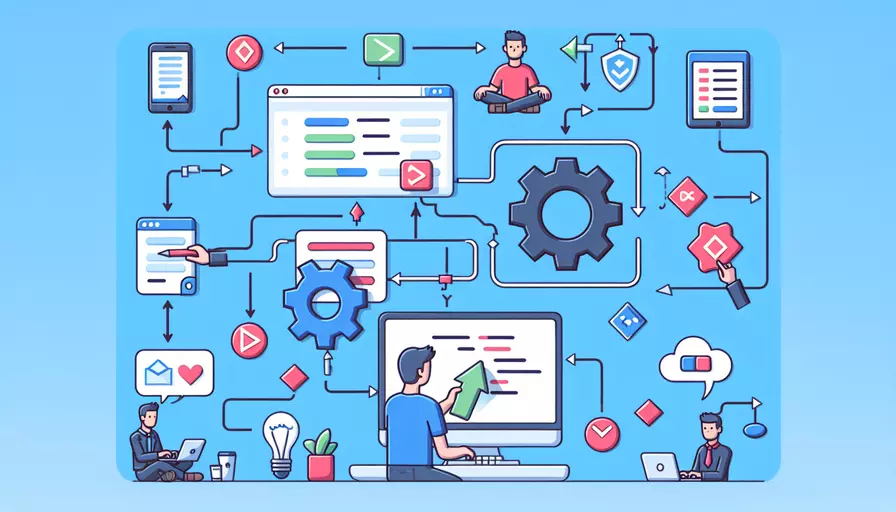
Vue和PHP结合的方式主要有以下几种:1、通过API接口进行数据交互;2、使用PHP渲染Vue组件;3、使用Vue CLI和PHP构建全栈应用。下面将详细描述这些方法的具体实现和使用场景。
一、通过API接口进行数据交互
- 创建API接口:使用PHP框架(如Laravel、Symfony等)创建RESTful API接口,将数据通过JSON格式返回给前端。
- 前端请求API:在Vue项目中,通过Axios等HTTP库发送请求,获取数据并更新视图。
- 数据绑定与展示:Vue通过其双向数据绑定特性,将获取到的数据展示在页面上。
详细步骤:
| 步骤 | PHP侧操作 | Vue侧操作 |
|---|---|---|
| 1 | 创建PHP项目,安装框架(如Laravel) | 创建Vue项目,安装必要的依赖(如Axios) |
| 2 | 定义API路由,创建控制器方法 | 在Vue组件中使用Axios发送HTTP请求 |
| 3 | 在控制器方法中编写业务逻辑,返回JSON数据 | 在Vue中处理请求结果,更新视图 |
| 4 | 测试API接口,确保数据正确返回 | 测试前端功能,确保数据正确展示 |
实例说明:
假设我们要实现一个简单的用户信息展示功能,后端使用PHP的Laravel框架,前端使用Vue。
PHP侧:
// routes/api.php
Route::get('/users', 'UserController@index');
// app/Http/Controllers/UserController.php
namespace App\Http\Controllers;
use App\Models\User;
use Illuminate\Http\Request;
class UserController extends Controller
{
public function index()
{
$users = User::all();
return response()->json($users);
}
}
Vue侧:
// src/components/UserList.vue
<template>
<div>
<ul>
<li v-for="user in users" :key="user.id">{{ user.name }}</li>
</ul>
</div>
</template>
<script>
import axios from 'axios';
export default {
data() {
return {
users: []
};
},
mounted() {
axios.get('http://your-api-url/api/users')
.then(response => {
this.users = response.data;
})
.catch(error => {
console.error(error);
});
}
};
</script>
二、使用PHP渲染Vue组件
- 模板渲染:在PHP模板文件中直接嵌入Vue组件代码,利用PHP的模板引擎(如Blade、Twig等)渲染Vue组件。
- 数据传递:通过PHP将数据渲染到模板中,并在Vue组件中使用这些数据。
- 前后端整合:确保前后端数据一致性,并进行必要的样式和逻辑调整。
详细步骤:
| 步骤 | PHP侧操作 | Vue侧操作 |
|---|---|---|
| 1 | 创建模板文件,将Vue组件代码嵌入其中 | 创建Vue组件,并确保其可以独立运行 |
| 2 | 使用模板引擎(如Blade)传递数据 | 在Vue组件中接收并使用传递的数据 |
| 3 | 渲染模板,确保数据正确输出 | 调整组件样式和逻辑,确保功能正常 |
| 4 | 整合前后端,进行测试和优化 | 测试前端功能,确保数据正确展示 |
实例说明:
假设我们要在一个PHP页面中嵌入一个显示用户信息的Vue组件,后端使用Laravel。
PHP侧:
<!-- resources/views/user.blade.php -->
<!DOCTYPE html>
<html lang="en">
<head>
<meta charset="UTF-8">
<meta name="viewport" content="width=device-width, initial-scale=1.0">
<title>User Information</title>
</head>
<body>
<div id="app">
<user-list :users="{{ json_encode($users) }}"></user-list>
</div>
<script src="{{ mix('js/app.js') }}"></script>
</body>
</html>
Vue侧:
// src/components/UserList.vue
<template>
<div>
<ul>
<li v-for="user in users" :key="user.id">{{ user.name }}</li>
</ul>
</div>
</template>
<script>
export default {
props: {
users: {
type: Array,
required: true
}
}
};
</script>
三、使用Vue CLI和PHP构建全栈应用
- 项目分层:将Vue和PHP项目分别管理,前端使用Vue CLI构建,后端使用PHP框架(如Laravel)构建。
- 跨域处理:配置CORS(跨域资源共享),确保前后端可以正常通信。
- 构建和部署:分别构建前端和后端项目,并进行部署。
详细步骤:
| 步骤 | PHP侧操作 | Vue侧操作 |
|---|---|---|
| 1 | 创建PHP项目,安装框架(如Laravel) | 使用Vue CLI创建前端项目 |
| 2 | 配置API接口,处理业务逻辑 | 创建Vue组件,进行前端开发 |
| 3 | 配置CORS,确保跨域请求正常 | 配置Axios或其他HTTP库,发送请求 |
| 4 | 部署PHP项目,确保API可访问 | 构建Vue项目,将静态文件部署到服务器 |
实例说明:
假设我们要实现一个用户信息管理系统,前端使用Vue CLI,后端使用Laravel。
PHP侧:
// routes/api.php
Route::get('/users', 'UserController@index');
Route::post('/users', 'UserController@store');
// app/Http/Controllers/UserController.php
namespace App\Http\Controllers;
use App\Models\User;
use Illuminate\Http\Request;
class UserController extends Controller
{
public function index()
{
$users = User::all();
return response()->json($users);
}
public function store(Request $request)
{
$user = User::create($request->all());
return response()->json($user, 201);
}
}
// config/cors.php
return [
'paths' => ['api/*'],
'allowed_methods' => ['*'],
'allowed_origins' => ['*'],
'allowed_headers' => ['*'],
];
Vue侧:
// src/components/UserList.vue
<template>
<div>
<ul>
<li v-for="user in users" :key="user.id">{{ user.name }}</li>
</ul>
<form @submit.prevent="addUser">
<input v-model="newUser.name" placeholder="Enter user name">
<button type="submit">Add User</button>
</form>
</div>
</template>
<script>
import axios from 'axios';
export default {
data() {
return {
users: [],
newUser: {
name: ''
}
};
},
mounted() {
axios.get('http://your-api-url/api/users')
.then(response => {
this.users = response.data;
})
.catch(error => {
console.error(error);
});
},
methods: {
addUser() {
axios.post('http://your-api-url/api/users', this.newUser)
.then(response => {
this.users.push(response.data);
this.newUser.name = '';
})
.catch(error => {
console.error(error);
});
}
}
};
</script>
总结:结合Vue和PHP的方法有多种,常见的有通过API接口进行数据交互、使用PHP渲染Vue组件、以及使用Vue CLI和PHP构建全栈应用。每种方法各有优劣,选择适合自己的项目需求和开发习惯的方式是关键。为了更好地结合Vue和PHP,建议开发者熟悉两者的基本操作和最佳实践,并不断优化开发流程,提高开发效率和代码质量。
相关问答FAQs:
1. 为什么要结合Vue和PHP?
Vue是一种流行的JavaScript框架,用于构建现代化的用户界面。而PHP是一种强大的服务器端编程语言,用于处理后端逻辑和与数据库交互。将Vue和PHP结合起来可以实现前后端的分离开发,提高开发效率和用户体验。
2. 如何将Vue和PHP结合起来?
首先,您需要在前端使用Vue框架进行页面开发,并使用Vue的组件化思想来构建可重用的UI组件。然后,您可以使用Vue的axios库来发送异步请求,与后端的PHP接口进行通信。
在后端,您可以使用PHP编写API接口,处理前端发送过来的请求,并与数据库进行交互。您可以使用PHP的框架(如Laravel或Symfony)来简化后端开发过程,并提供更好的安全性和性能。
3. 如何在Vue中使用PHP接口?
您可以使用Vue的axios库来发送HTTP请求,并与后端的PHP接口进行通信。首先,您需要在Vue项目中安装axios库:
npm install axios
然后,在Vue组件中使用axios发送请求,例如:
import axios from 'axios';
export default {
data() {
return {
users: []
};
},
mounted() {
axios.get('http://example.com/api/users')
.then(response => {
this.users = response.data;
})
.catch(error => {
console.error(error);
});
}
}
在上面的示例中,我们使用axios发送GET请求来获取后端PHP接口返回的用户数据,并将其存储在Vue组件的数据中。
在后端,您需要编写PHP接口来处理前端发送过来的请求。例如,您可以使用PHP的Slim框架来创建API路由:
$app->get('/api/users', function ($request, $response) {
$users = [
['name' => 'John', 'email' => 'john@example.com'],
['name' => 'Jane', 'email' => 'jane@example.com']
];
return $response->withJson($users);
});
在上面的示例中,我们创建了一个返回用户数据的GET接口。您可以根据实际需求进行更复杂的逻辑处理和数据库交互。
通过以上步骤,您就可以在Vue中使用PHP接口了,实现前后端的数据交互和协同工作。这样的结合可以帮助您构建现代化的Web应用程序,并提供良好的用户体验。
文章标题:vue和php如何结合,发布者:不及物动词,转载请注明出处:https://worktile.com/kb/p/3673774

 微信扫一扫
微信扫一扫  支付宝扫一扫
支付宝扫一扫 